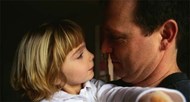 Your child is looking downcast and more quiet than usual. Do you continue to focus in on the TV, hoping his phase will go away, or do you address the problem? What to do? When my daughter was 3 years old, a long time ago, I was talking to a friend in the back yard. She came up to me and pulled on my pant leg. “Daddy, I need some attention.” Not your typical 3 year old, and not the kind of attention-getting behavior our children give us. However your child acts, pay attention to the cues. Rachel gave me a verbal cue. Most children her age will go with a nonverbal cue, like the downcast look and quiet funk. “Hey, Punkin. What’s going on in that noodle of yours?” This is a good lead-in and gives your child opportunity to make her nonverbal behavior verbal. If they don’t respond, accept that and offer to be available to talk when they are ready. If they do respond, hear them out, use active listening and be empathetic. “So, what I hear you saying is…” “Let me get this straight. You feel…?” When you see their emotional fever drop, suggest, “I have some thoughts about what’s up. Do you want to hear them?” It’s so powerful when you ask your child’s permission to counsel, regardless of their age. Children feel empowered and are more likely to act on what you have to offer. If you offer wise counsel and they don’t want it right then, it falls on deaf ears. Asking their permission opens up their ears to what you have to say. Be creative in your problem-solving and active listening. Children love to be outside the box. The core feelings for kids are mad, bad, sad, and glad. That’s all you will get and that’s not much. “You feel put upon, vulnerable, excluded.” Take the core feelings a little further. “You sound thrilled, beside yourself, joyful.” These more expressive feelings may be both on target and also will help your child be more creative in expressing what they feel. Helping your child through a problem? Pay attention and be creative.
0 Comments
Leave a Reply. |
Archives
January 2024
Categories
All
|

 RSS Feed
RSS Feed
